CHAPTER 5
Organization for the Breach
by
CPT Wayne Sodowsky, 70th Engr Bn,
and
CPT Johnathan Thomas, 3 ID Engr Bde
 |
 |  |
| "A
leader is a man who can adapt principles to circumstances." "Make your plans
fit the circumstances."
--Patton |
Introduction
Currently, there are only two heavy divisions that have four maneuver companies per battalion; all others have already converted to the three-company organization. This shift has created problems in task organization, as maneuver commanders must adjust to reduction in combat power as well as the loss of one command and control (C2) node. In many offensive operations, especially where breaching is probable, commanders run out of C2nodes as they organize into the Support Force, Breach Force, Assault Force, and Reserve. In the three-company organization, engineers are frequently taking on the role of the Breach Force instead of just executing the reduction of the obstacles. The intent of this chapter is to discuss several examples to overcome this shortfall and to describe some of the advantages and disadvantages of each. These examples are not meant as a "cookie cutter solution," but rather to show that there are different ways to solve this problem and that we must base our decisions on sound planning and analysis. The areas for discussion are:
The organization used for these examples is an armor brigade, made up of two armor battalions and one mechanized battalion. These examples are meant only to serve as a basis for discussion. Obviously, if we were to look at a mechanized heavy brigade, the task organization would be much different, but the concept and considerations to determine the task organization remain the same.
Company-Level Breach: Engineer Platoon as the Breach Force
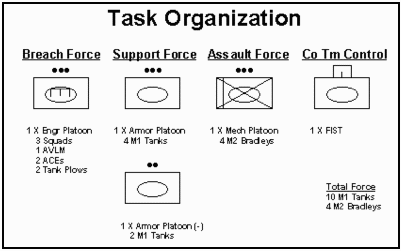
Advantages:
1. Engineers are integrated and very responsive to the maneuver commander.
2. Provides more combat power for suppression in the breach and reduction areas.
3. Additional C2node. Allows for flexibility by utilizing an additional armor platoon to the Support, Assault, or Reserve Forces.
Disadvantages:
1. Lacks combat power to conduct breaching operations against any enemy larger than platoon size overwatching the obstacle.
2. Breach Force lacks combat power for local security and suppression. Only contains engineer platoon plus plow tanks.
Company-Level Breach: Maneuver Platoon as the Breach Force

Advantages:
1. Stronger security at the point of breach because of additional combat power within the Breach Force.
2. Better C2for the Breach Force elements. An armor platoon leader controls the security element, while an engineer platoon leader controls the reduction element.
Disadvantages:
1. Lacks combat power to conduct breaching operations against any enemy larger than platoon size overwatching the obstacle.
2. Engineer platoon leader is less responsive to company team commander as the engineer platoon is working for the armor platoon leader; possible unit of command problem.
3. Lacks sufficient combat power for suppression of enemy forces.
Task Force-Level Breach: Company Team as the Breach Force.
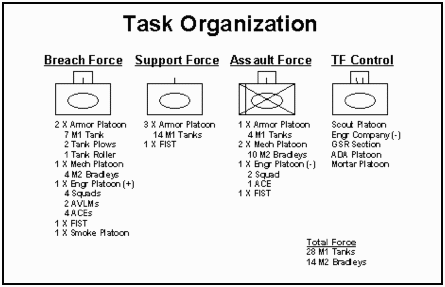
Advantages:
1. Contains a mix of combat and reduction forces in the Breach and Assault Forces.
2. Engineers are very responsive to company teams because of attached or OPCON relationship.
3. Breach Force contains a FIST for fire support.
Disadvantages:
1. No reserve. Even if a platoon is broken out for the reserve, there is no C2.
2. Either the Support Force or the Assault Force goes without any engineer support.
3. If the Support Force goes without engineer support, they should have plow tanks with them and are prepared to use organic assets to mark possible breach lanes.
4. Breach Force is a large signature. Massed engineer equipment is easily recognized.
5. C2of the Breach Force can be difficult. The Breach Force contains five platoons, which can be difficult to maneuver.
Task Force-Level Breach: Engineer Company as the Breach Force.
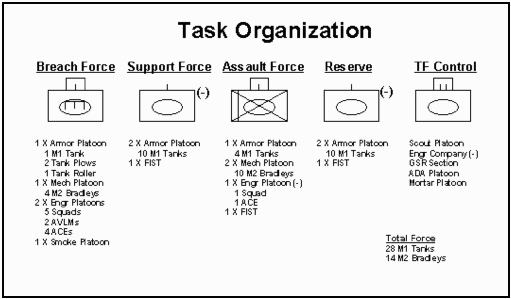
Advantages:
1. Maintains a two-platoon reserve with C2.
2. Masses engineer effort with the Breach Force.
3. Provides more flexibility for engineer tasks. Engineers are centrally controlled and can, therefore, have more "be-prepared" missions.
Disadvantages:
1. Engineer commander must maneuver mechanized and armor platoons. These should be experienced platoon leaders to allow the engineer commander to keep a broader focus.
2. Breach Force lacks a FIST for indirect fire support.
3. Limited mobility support to Support Force, Assault Force, and Reserve. The Breach Force must maintain flexibility to support the entire task force.
4. Breach Force is an easy signature. There are fewer combat forces and, therefore, a larger percentage of engineer vehicles.
5. The engineer commander is concerned with maneuver; there is the potential to lose focus on synchronizing SOSRA and engineer support to the entire task force.
Brigade-Level Breach: Maneuver Task Force as the Breach Force.
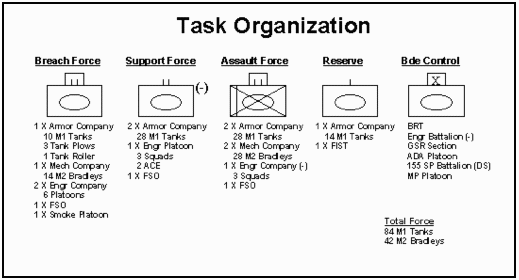
Advantages:
1. Engineer support very responsive to maneuver commanders.
2. Breach Force contains FSO for fire support.
3. Masses engineer effort within the Breach Force. Can work on multiple breach lanes simultaneously.
Disadvantages:
1. Task organization dictates a limited reserve. Company commander works directly to the brigade commander.
2. Reduced engineer effort with the Assault Force to maintain mobility in protective obstacles.
3. Reduced engineer effort with the Support Force to maintain mobility in movement to, and in occupying, SBF position.
Brigade-Level Breach: Engineer Task Force as the Breach Force.
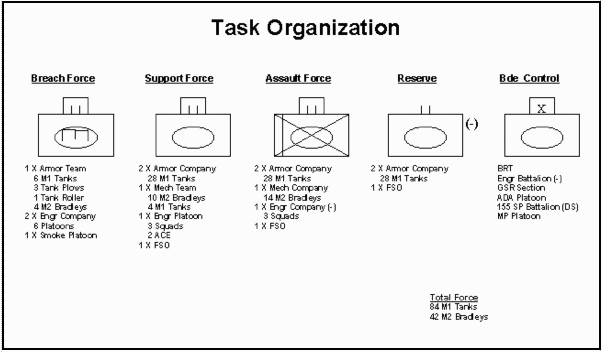
Advantages:
1. Masses breach assets to the Breach Force.
2. Maintains flexibility with breach assets because of centralized C2. Breach Force must "be prepared" to provide mobility support to the other Task Forces. One technique is through the use of a mobility reserve.
Disadvantages:
1. Maneuver role for the engineer commander.
2. There is the potential for the engineer to lose focus of engineer support to the brigade as he commands the Breach Force.
3. Breach Force lacks an FSO.
4. Lacks engineer effort with the Assault Force to maintain mobility in protective obstacles.
5. Breach Force is easily recognized and targeted.
Other Considerations:
1. The span of control depends on the abilities of the commander but normally should be between two and five subordinate elements (i.e., a company team should contain between two and five platoons) to maintain adequate C2.
2. Engineers and tank plows are not the only ones that must be considered in the task organization. MP, ADA, smoke platoon, FIST/FSO, COLT, and GSR assets must also be considered. Detailed IPB will aid the commander in determining the placement of these assets within the task organization.
3. The smoke platoon can be placed with either the Support Force or with the Breach Force depending on the wind direction and the enemy force that we are trying to obscure. The key consideration here is visibility of the objective area and communication with all other smoke assets.
4. If the Breach Force commander is an engineer, realize that he does not come with a FIST/FSO. Considerations must be given as to whether the Breach Force even needs this asset, and, if so, could the engineer be given the reserve force's FIST/FSO? Either way, the commander is accepting risk, but consider the fact that normally the reserve will move to support one of the other forces that already contains a FIST/FSO.
5. ADA support mission remains the same regardless of task organization. Therefore, they may be task-organized with the headquarters element and travel vicinity a subordinate unit, or task-organized with a subordinate unit. Regardless, his placement should be based upon good analysis of where he can best support the TF/Bde. They may be able to move with the Support Force to provide them coverage during movement and then find a vantage point overwatching the point of breach to provide ADA coverage over both the Breach and Support Forces. That coverage becomes part of the definition for "setting the conditions."
6. The MPs are another group that can sometimes be left out when considering breaching operations. The MPs can play a vital role in providing traffic control and limited local security once the breach is established, thus freeing up valuable engineer breaching assets for later use. They should travel in the vicinity of, but not necessarily task-organized with, the Breach Force.
7. A technique for providing flexibility is through the use of a mobility reserve. Normally, this can only be accomplished when engineer assets are massed within the breach force. If engineer assets are piecemealed out to the force, there generally is not enough left over for a mobility reserve. The basic concept is to establish a reduction force that can:
The most important aspect when planning the use of a mobility reserve is to have clear commitment criteria on when and where to use them. Ensure this information is on the Decision Support Template (DST). It is easy to get so involved in conducting a breach that you forget about the mobility reserve and miss out on an opportunity because no one is looking at the big picture.
8. Engineers in the Engineer Bradley Fighting Vehicle (EBFV). As engineers are fielded with the Bradley, this will free up some of the combat power normally associated with security within the Breach Force. With engineers as the Breach Force, the Mechanized unit normally task-organized may be shifted to the Assault Force or to strengthen the Reserve since the EBFV will be able to provide its own security. However, in restrictive terrain, the Mechanized team will be required to dismount and secure the breach site by force. Another consideration is a danger of fighting the engineers as another Mechanized company instead of focusing on the primary mission as engineers.
Conclusion
Task organization should be designated during COA development as part of the reverse breach planning process and refined through COA analysis and the commander's decision, not a set template or an SOP just pulled out for a specific-type mission. Drills are good, but there should never be a default that we always use for breaching operations. There are too many factors that change between one scenario and the next to have one set template. All of these task organizations are complex and present significant C2challenges. Repetitive training at all levels, under tough conditions, will be crucial to achieve success against a determined enemy.
 |
 |  |
|
NEWSLETTER
|
| Join the GlobalSecurity.org mailing list |
|
|
|

